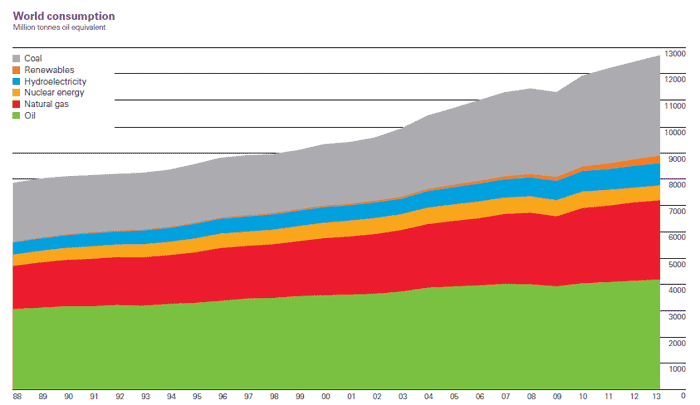One of our favorite reports each year is the BP Statistical Review of World Energy, and as usual the 2014 report has been released here in June, once again presenting simply an incredible amount of information relative to energy matters across the globe.
Amazingly, this is the 63rd edition of the study, which reports on 2013 energy data.
The year 2013 saw an acceleration in the growth of global energy consumption, despite a stagnant global economy. In line with that economic pattern, energy consumption growth was below average in the non-OECD countries, driven by China, and above average in the mature economies of the OECD, driven by the US.
Nevertheless, emerging economies continue to dominate changes in global energy demand, accounting for 80% of growth last year, and nearly 100% of growth over the past decade, as in many years energy consumption in developed economies has actually decreased.
While North American energy consumption rose in 2013, EU consumption continued to decline, hitting the lowest level since 1995 despite economic growth of 35% over this period.
The US saw the world's largest increase in oil production last year, offsetting the numerous disruptions seen elsewhere across the globe and keeping prices stable. In fact, the US increase in 2013 was one of the biggest oil production jumps the world has ever seen in a single year. This rise was of course driven by massive investment in shale and other "tight" formations as oil sources.
Renewable energy sources continue to see strong growth, albeit at low absolute levels. The report says that renewables now account for more than 5% of global power output and nearly 3% of primary energy consumption.
However, it notes that "The challenge of sustaining expensive subsidy regimes, however, has become visible where penetration rates are highest, namely the below-average growth of Europe's leading renewable producers, who are grappling with weak economic growth and strained budgets," perhaps jeopardizing continued or at least expanded subsidies there.
Consumption and production increased for all fuels - that would of course include coal - reaching record levels for every fuel type except nuclear power. For each of the fossil fuels, global consumption rose more rapidly than production – a potentially worrying sign for the future. The rise in energy consumption naturally means that growth in global CO2 emissions from energy use also accelerated in 2013, although BP believes that growth remained below recent averages.
Total energy consumption worldwide was up 2.3% in 2013, BP estimates, up from 1.8% in 2012 but a bit below recent the 10-year average of 2.5%.
Robust US growth (+2.9%) accounted for all of the net increase in OECD country consumption, while consumption in the EU and Japan fell by 0.3% and 0.6%, respectively.
One of our favorite charts from the report each year is the one provided below, which shows global energy consumption by energy type.
2013 Global Consumption by Energy Type

Source: BP Statistical Review of World Energy 2014
BP says that while oil remained the number 1 energy source yet again, things are changing. Oil's 32.9% share of global energy consumption was the lowest since BP began tracking the measure in 1965, and meant oil lost market share for the fourteenth consecutive year.
Despite concerns about its level of CO2 emissions, growth in energy consumption from coal continued on. Coal-based energy consumption grew 3% in 2013, making it the fastest growing fossil fuel.
Coal's share of global primary energy consumption reached 30.1%, the highest level since 1970. 89% of the growth in coal-based energy consumption, however, came from non-developed economies, but that really means China, which accounted for 67% in the growth in coal consumption. But for the first time in awhile, US actually also saw a small level of growth in coal consumption as well.
We'll share more data from this excellent report in part 2 of this article.
The full report can be found here: BP Statistical Review of World Energy 2014
Any reaction to this BP data? Let us know your thoughts at the Feedback button below.

TheGreenSupplyChain.com is now Twittering! Follow us at www.twitter.com/greenscm
|